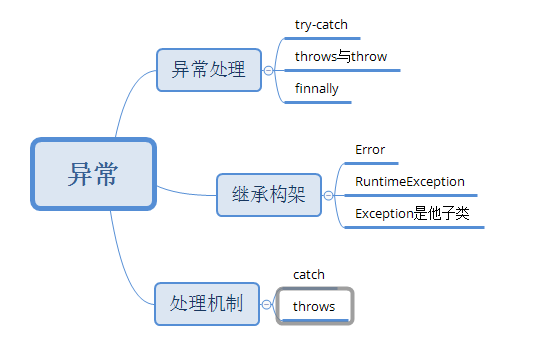201521123102 《Java程序设计》第9周学习总结
2017-04-22 20:22 花雨芸 阅读(169) 评论(0) 编辑 收藏 举报1. 本周学习总结
1.1 以你喜欢的方式(思维导图或其他)归纳总结异常相关内容。

2.书面作业
1.常用异常
题目5-1
1.2 自己以前编写的代码中经常出现什么异常、需要捕获吗(为什么)?应如何避免?
经常出现数组越界导致的异常,无需使用try-catch进行捕获处理,编写时注意数组大小
1.3 什么样的异常要求用户一定要使用捕获处理?
answer:Exception中除了RuntimeException的其他子类都需要使用捕获处理。它们需要从错误中恢复的情况,所以要求用户一定要使用捕获处理。
2.处理异常使你的程序更加健壮
题目5-2
2.2 实验总结
处理输入数组元素时,要考虑数组下标位置问题,在容易出错的地方进行try-catch即可。
3.throw与throws
题目5-3
3.2 阅读Integer.parsetInt源代码,结合3.1说说抛出异常时需要传递给调用者一些什么信息?
public static int parseInt(String s) throws NumberFormatException {
return parseInt(s,10);
}
public static int parseInt(String s, int radix)
throws NumberFormatException
{
if (s == null) {
throw new NumberFormatException("null");
}
if (radix < Character.MIN_RADIX) {
throw new NumberFormatException("radix " + radix +
" less than Character.MIN_RADIX");
}
if (radix > Character.MAX_RADIX) {
throw new NumberFormatException("radix " + radix +
" greater than Character.MAX_RADIX");
}
int result = 0;
boolean negative = false;
int i = 0, len = s.length();
int limit = -Integer.MAX_VALUE;
int multmin;
int digit;
if (len > 0) {
char firstChar = s.charAt(0);
if (firstChar < '0') { // Possible leading "+" or "-"
if (firstChar == '-') {
negative = true;
limit = Integer.MIN_VALUE;
} else if (firstChar != '+')
throw NumberFormatException.forInputString(s);
if (len == 1) // Cannot have lone "+" or "-"
throw NumberFormatException.forInputString(s);
i++;
}
multmin = limit / radix;
while (i < len) {
// Accumulating negatively avoids surprises near MAX_VALUE
digit = Character.digit(s.charAt(i++),radix);
if (digit < 0) {
throw NumberFormatException.forInputString(s);
}
if (result < multmin) {
throw NumberFormatException.forInputString(s);
}
result *= radix;
if (result < limit + digit) {
throw NumberFormatException.forInputString(s);
}
result -= digit;
}
} else {
throw NumberFormatException.forInputString(s);
}
return negative ? result : -result;
}
如上为pasetInt的源代码,阅读源代码,在抛出异常的时候应该具体情况具体分析,用if语句指出不同情况,然后抛出对应的异常,
比如3.1的题目要求begin>0,当输入小于0的时候,抛出异常,并提示begin应该小于0。
4.函数题
题目4-1(多种异常的捕获)
4.2 一个try块中如果可能抛出多种异常,捕获时需要注意些什么?
1.子类异常必须放在父类异常前面否则会只执行父类异常的捕获而不执行子类异常的捕获导致编译错误;2.如果指示不同类型的问题的多种异常都是受检异常,那么它们必须都列在方法的throws子句中之间以逗号分开
**5.为如下代码加上异常处理
byte[] content = null;
FileInputStream fis = new FileInputStream("testfis.txt");
int bytesAvailabe = fis.available();//获得该文件可用的字节数
if(bytesAvailabe>0){
content = new byte[bytesAvailabe];//创建可容纳文件大小的数组
fis.read(content);//将文件内容读入数组
}
System.out.println(Arrays.toString(content));//打印数组内容
5.1 改正代码,让其可正常运行。注1:里面有多个方法均可能抛出异常。注2:要使用finally关闭资源。**

5.2 使用Java7中的try-with-resources来改写上述代码实现自动关闭资源.
byte[] content = null;
FileInputStream fis = new FileInputStream("testfis.txt");
int bytesAvailabe = fis.available();//获得该文件可用的字节数
if(bytesAvailabe>0){
content = new byte[bytesAvailabe];//创建可容纳文件大小的数组
fis.read(content);//将文件内容读入数组
}
System.out.println(Arrays.toString(content));//打印数组内容
catch (FileNotFoundException e) {
// TODO Auto-generated catch block
System.out.println(e);}


